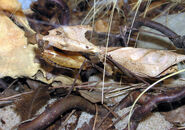Assessment |
Biopsychology |
Comparative |
Cognitive |
Developmental |
Language |
Individual differences |
Personality |
Philosophy |
Social |
Methods |
Statistics |
Clinical |
Educational |
Industrial |
Professional items |
World psychology |
Animals · Animal ethology · Comparative psychology · Animal models · Outline · Index
In zoology, crypsis is the ability of an organism to avoid observation. A cryptic animal may do this through camouflage, nocturnality, subterranean lifestyle, transparency, or mimicry. There is a strong evolutionary pressure for animals to blend into their environment or conceal their shape; for prey animals to avoid predators and for predators to be able to sneak up on prey. (Exceptions include: large herbivores without natural enemies; brilliantly-colored birds which rely on flight to escape predators; and venomous or poisonous animals which advertise with bright colors.) Cryptic animals include the tawny frogmouth (feather patterning resembles bark), the tuatara (hides in burrows all day; nocturnal), some jellyfish (transparent), the leafy sea dragon, and the flounder (covers itself in sediment). The distinction between camouflage and mimicry is arbitrarily defined in that mimicry requires that the "model" be another organism, rather than the surroundings; the arbitrary nature of this distinction between the two phenomena can be seen by considering animals that resemble twigs, bark, leaves or flowers, in that they are often classified as camouflaged (a plant does constitute the "surroundings"), but sometimes classified as mimics (a plant is also an organism). Either way, the animal is considered cryptic.
Crypsis is usually most effective when an animal is still. Cryptic animals that forage during daylight may be sit-and-wait predators, taking advantage of their ability to blend into their background. Alternatively, cryptic animals may be active predators in darkness and use their crypsis while inactive. Some cryptic animals also simulate natural movement, e.g., of a leaf in the wind. This is called procryptic behaviour or habit. Other animals attach or attract natural materials to their body for concealment.
A few animals have chromatic response, changing color in changing environments, either seasonally (ermine, snowshoe hare) or far more rapidly with chromatophores in their integument (chameleon, the cephalopod family).
Some animals, notably in aquatic environments, also take steps to camouflage the odours they create that may attract predators.[How to reference and link to summary or text]
Countershading (or obliterative camouflage), the use of different colors on upper and lower surfaces in graduating tones from a light belly to a darker back, is common in the sea and on land. This is sometimes called Thayer's law, after Abbott H. Thayer who published a paper on the form in 1896.
There is often a self-perpetuating co-evolution, or evolutionary arms race, between the perceptive abilities of animals for whom it is beneficial to be able to detect the cryptic animal, versus the cryptic characteristics of the hiding species. Different aspects of crypsis and sensory abilities may be more or less pronounced in given predator-prey species pairs.
Zoologists need special methods to study cryptic animals including biotelemetry techniques such as radio tracking, mark and recapture, and enclosures or exclosures.
Cryptic animals tend to be overlooked in studies of biodiversity and ecological risk assessment.
Gallery[]
Topics in evolutionary ecology
|
|---|
| Patterns of evolution: Convergent evolution • Evolutionary relay • Parallel evolution |
| Colour and shape: Aposematism • Mimicry • Crypsis |
| Interactions between species: Mutualism • Cooperation • Predation • Parasitism |
| This page uses Creative Commons Licensed content from Wikipedia (view authors). |



